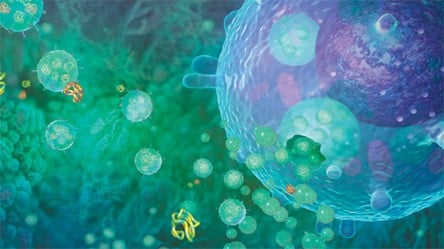Overview
Extracellular vesicles (EVs) are a heterogenous family of membranous molecules that are secreted by virtually all living cells. EVs are broadly divided into three categories based on the nature of their cellular biogenesis: exosomes, microvesicles and apoptotic bodies.
- Exosomes range in size from 30-150 nm in diameter and are formed by the inward budding of the limiting endosomal membrane, and are exocytosed into the cellular milieu as complete particles.
- Microvesicles (MVs), on the other hand, are generated through outward budding and fission of the plasma membrane and have a much broader size range (100-1,000 nm in diameter).
- Apoptotic Bodies are produced by cells undergoing organized cell death (apoptosis). They have a broad size range (50-5,000 nm), thus they overlap with exosomes and MVs.
Exosomes and MVs are currently the focus of most scientific research. Despite differences in subcellular origination, common intracellular mechanisms and machinery are involved in the production of both particle types
Facilitating intercellular communication
EVs facilitate intercellular communication by serving as delivery vehicles for transferring a range of different biologics, primarily mRNA, proteins, and lipids. The identity and quantity of the cargo depends largely on the cell type, and the presence and abundance of the cargo itself can influence biogenesis. However, there is also growing evidence that cells have the ability to modulate both the biogenesis and contents of their EVs as a function of their physiological or pathological state.
Importantly, exosomes and MVs are often quite similar in terms of molecular cargo, as well as physical and biochemical properties. Due to their role in a number of important in vivo functions (intercellular communication, modulation of gene transcription rates, induction & coordination of immune responses), there is much interest and potential in their use as drug delivery vehicles.
Challenges to isolating EVs
Although a number of methods have been described for isolating EVs and other sub-cellular particle, practical separation of exosomes form MVs is currently a challenge due to their overlapping size and similarities in morphology, surface protein expression and composition of inner contents. As such, developing and improving techniques for better separative resolution are an important area of focus.
Additionally, lack of suitable methodology for targeted interference of cellular machinery involved in EV assembly and packaging represents another limitation in broadening our understanding.
Despite these considerable hurdles, Beckman Coulter Life Sciences is dedicated to driving innovation in research through improvements in EV production and analysis. We offer a number of products and solutions to bring your basic and translational EV workflows to the next level.
Driving innovation in extracellular vesicle research requires pure preparations, proven reagents and accurate characterizations. We stand ready to enable the isolation, purification and analyses needed in your EV workflows.
Experience the precision our instruments and expertise can confer to extracellular vesicle research needs.

Basic EV Research
Learn about the questions we are trying to answer by researching EVs


